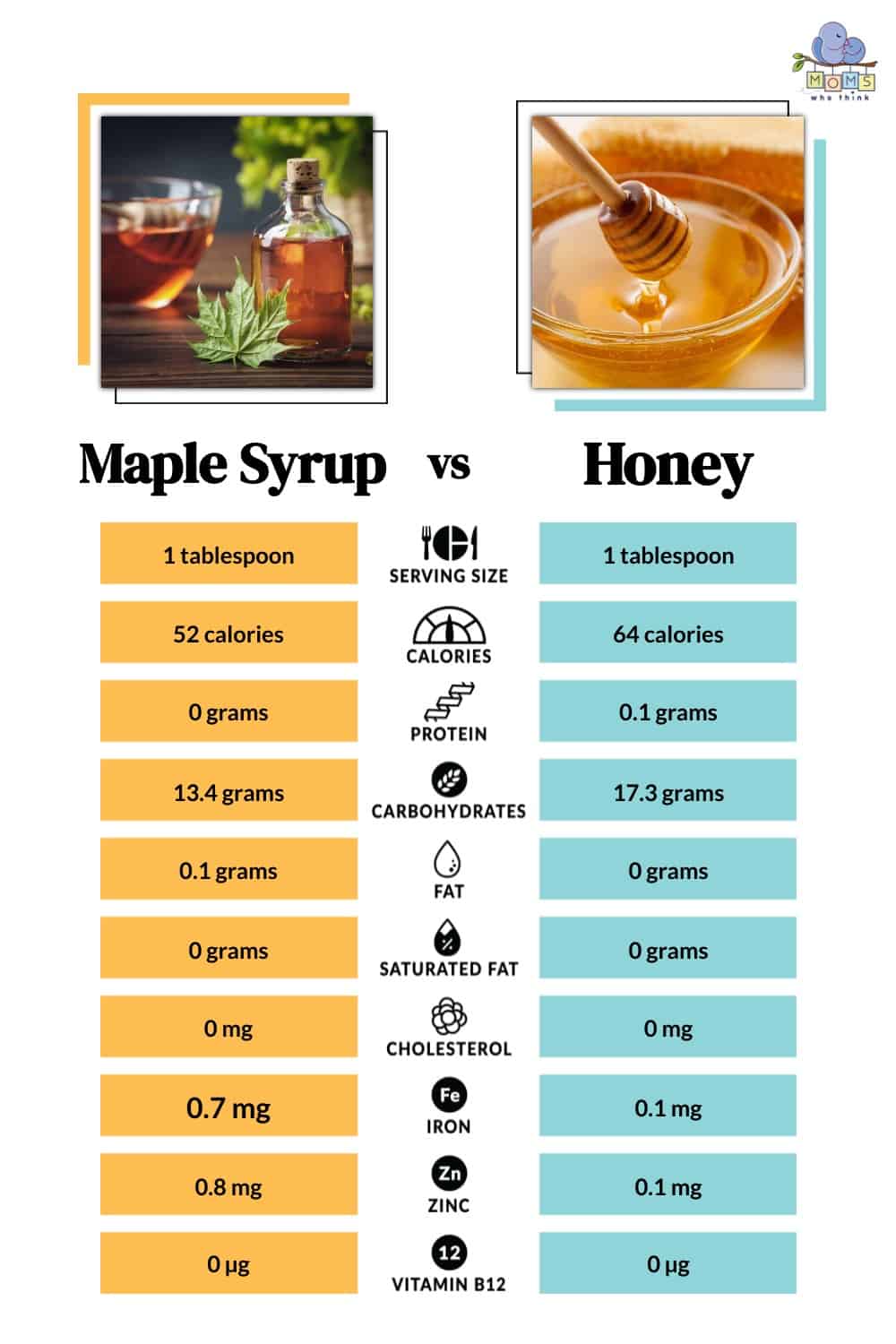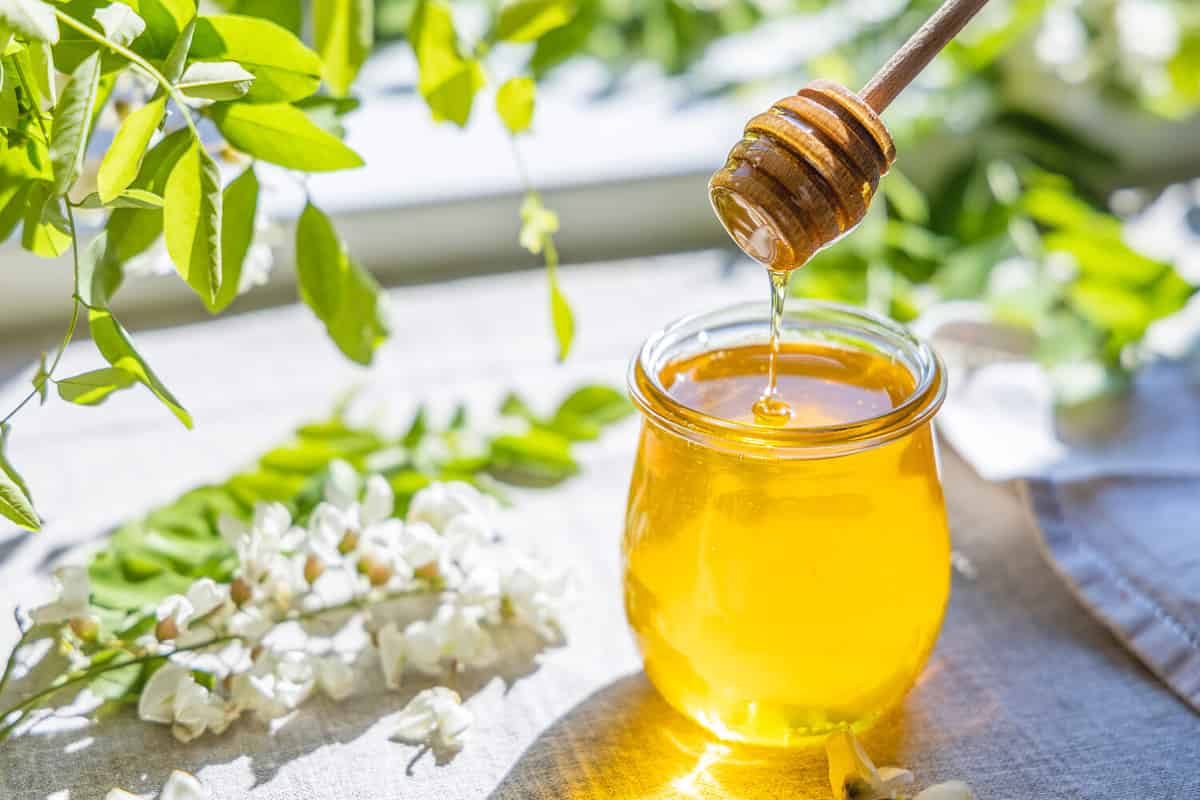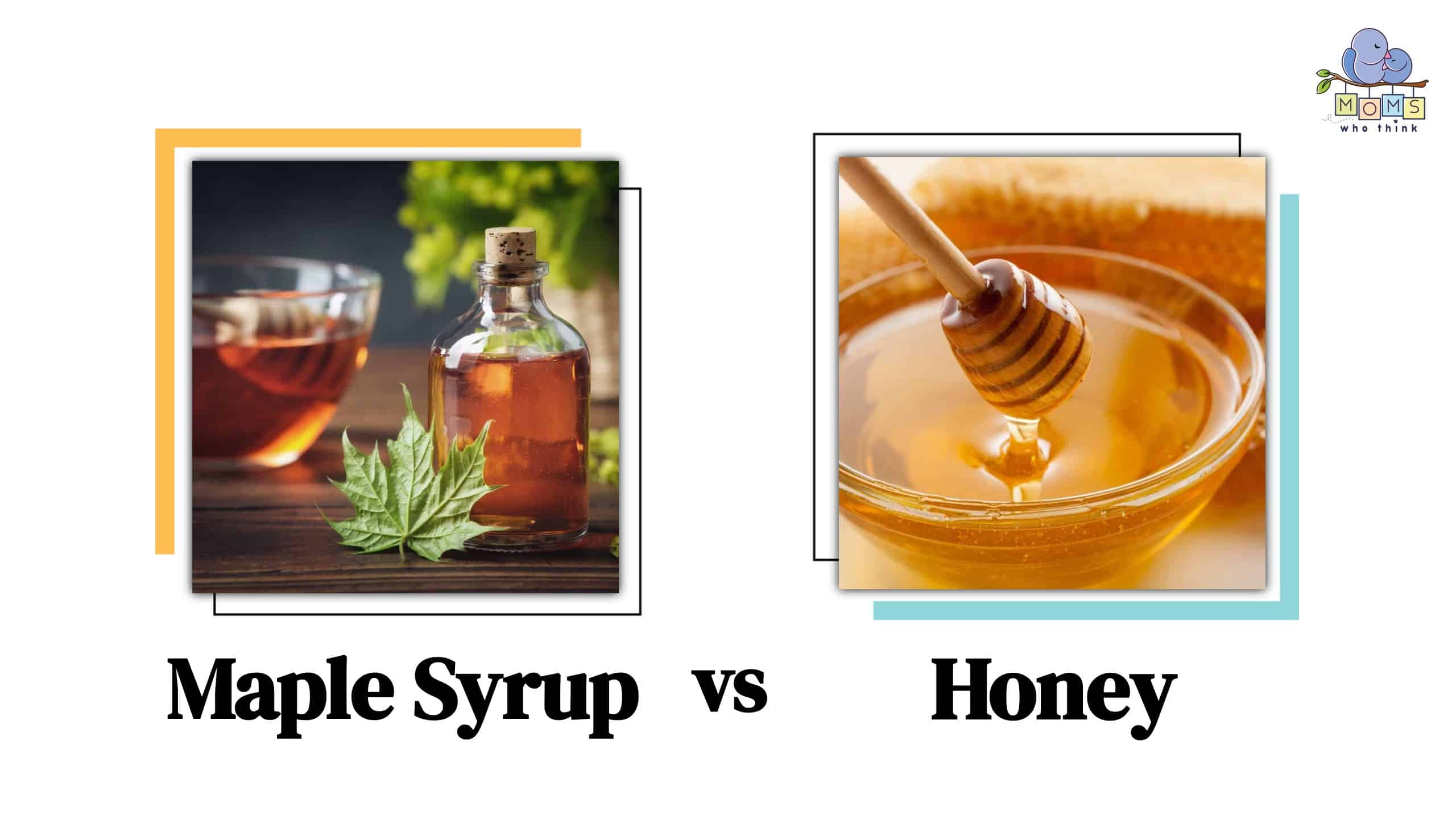In the quest for healthier alternatives to refined sugar, maple syrup, and honey have emerged as popular choices. Both natural sweeteners offer unique flavors and a touch of sweetness to various dishes. However, when it comes to choosing between the two, which one is truly the healthier option? In this article, we will delve into the key differences between maple syrup and honey, exploring their nutritional profiles and health benefits to determine which sweetener reigns supreme in terms of healthiness. So, let's settle the debate once and for all: Maple Syrup vs. Honey – which is the healthier sweetener?
Maple Syrup vs. Honey: Exploring 6 Key Differences
In order to determine which might be a healthier option for you, it is important to understand the key differences between maple syrup and honey, including its glycemic index, antioxidant profile, nutritional value, and more. Let’s explore 6 key differences between maple syrup and honey to help determine which might be a healthier sweetener!
1. Maple Syrup vs. Honey: Source
Source: Maple Syrup
Maple syrup comes from the sap of certain species of North American maple trees, primarily the sugar maple and black maple trees. The sap is collected by tapping the trees, which involves drilling a tap hole into the tree trunk and inserting a spout to direct the sap flow into a collection container. The sap is then boiled down to remove the water content, resulting in the thick and sweet maple syrup that we enjoy.
The process of boiling the sap concentrates the natural sugars present in the sap, transforming it into maple syrup. Maple syrup production is primarily carried out in regions with maple trees, such as Canada and parts of the United States, including the provinces of Quebec, Ontario, New Brunswick, Prince Edward Island, and Nova Scotia.
Source: Honey
Honey is made by honeybees through a process of collecting nectar from flowering plants. Bees visit flowers and collect the sweet liquid called nectar, which they store in a special honey stomach known as the crop. Inside the honey stomach, enzymes, including invertase, begin to break down the complex sugars in the nectar into simpler sugars that are less prone to crystallizing. The bees then return to the hive and regurgitate the nectar into honeycomb cells. Through constant fanning of their wings, the bees evaporate the water content from the nectar, transforming it into thick and sweet honey.
2. Maple Syrup vs. Honey: Flavor and Usage
Flavor: Maple Syrup
Maple syrup has a rich and sweet taste, often described as a combination of liquid caramel and butterscotch. It has a distinct flavor that sets it apart from other sweeteners. When poured over pancakes or waffles, it adds a delightful and indulgent touch to the meal.
The taste of maple syrup can vary slightly depending on factors such as the grade of syrup (e.g., golden, amber, dark), the region it comes from, and the specific maple trees used. Darker syrups tend to have a more pronounced maple flavor, while lighter syrups can be more delicate in taste. Overall, maple syrup offers a unique and enjoyable flavor experience.
Flavor: Honey
Honey flavors range from sweet and reminiscent of honeysuckle nectar to fruity with hints of berries, citrus, or vanilla. Some honey varieties have a buttery taste, while others can be pungent or even sour. The taste of honey is often described as a sensory experience, with nuances that can be appreciated by considering factors like the season and inhaling the aroma while tasting it. It is commonly used as a natural sweetener in tea, baking, and cooking.
3. Maple Syrup vs. Honey: Glycemic Index
Glycemic Index: Maple Syrup
Maple syrup has a lower glycemic index than honey, meaning it has a slower impact on blood sugar levels. Maple syrup has a glycemic index of around 54, which is lower than that of table sugar (around 65) and honey (around 58). This means that maple syrup raises blood sugar levels at a slower rate compared to these other sweeteners.
It's important to note that even though maple syrup has a lower glycemic index, it is still a concentrated source of sugar and should be consumed in moderation as part of a balanced diet.
Glycemic Index: Honey
The glycemic index of honey can vary depending on the type and source of honey. On average, honey has a glycemic index of around 58. However, it's important to note that different types of honey may have slightly different glycemic index values. For example, acacia honey has a lower glycemic index of around 32, while tupelo honey can have a higher glycemic index of up to 74.
Compared to table sugar, honey generally has a lower glycemic index. Table sugar has a glycemic index of around 60. However, it's worth noting that honey, like all carbohydrates, can still raise blood sugar levels quickly, although not as fast as sugar.
It's important for individuals with diabetes or those monitoring their blood sugar levels to consume honey in moderation and consider its impact on their overall carbohydrate intake. Consulting with a healthcare professional or registered dietitian can provide personalized guidance on incorporating honey into a balanced diet.
4. Maple Syrup vs. Honey: Antioxidant Content
Antioxidant Content: Maple Syrup
Maple syrup contains several antioxidants that can help reduce the damage caused by free radicals and inflammation, potentially reducing the risk of chronic diseases. It has been found to have higher antioxidant capacity compared to refined sugar, corn syrup, and agave nectar. It contains up to 24 different antioxidants, including phenolic compounds, which can help reduce oxidative stress and potentially prevent chronic diseases.
Darker syrups, such as Grade B, tend to have more antioxidants than lighter ones. However, it's important to note that the total antioxidant content of maple syrup is still relatively low compared to its sugar content. While maple syrup does contain beneficial antioxidants, it should still be consumed in moderation due to its high sugar content.
Antioxidant Content: Honey
Honey contains antioxidants, such as phenolic compounds and flavonoids, which contribute to its potential health benefits. The antioxidant content of honey can vary depending on factors like the type of honey and its floral source. Darker honey, like buckwheat honey, tends to have higher antioxidant levels compared to lighter varieties. These antioxidants play a role in food preservation and can help combat oxidative stress and reduce the risk of cardiovascular disease.
Honey has also been studied for its potential cough-suppressant properties and its use in promoting wound healing. However, it's important to consume honey in moderation due to its high sugar content. The antioxidant capacity and nutritional composition of honey can vary based on factors like the floral source and processing methods.
5. Maple Syrup vs. Honey: Nutritional Value

Nutritional Value: Maple Syrup
Maple syrup contains fewer calories and carbohydrates compared to honey. It is also a good source of minerals such as manganese and zinc.
Nutritional Value: Honey
Honey, on the other hand, provides small amounts of vitamins and minerals, including vitamin C, calcium, and iron.
6. Maple Syrup vs. Honey: Availability
Availability: Maple Syrup
Maple syrup can be found in stores and online retailers nationwide. It is available in various locations and can be purchased from different sources. For example, there are farms in Washington State that tap Bigleaf Maple Trees to produce maple syrup. In Wisconsin, maple syrup is graded and sold in different categories, such as Grade A and processing grade.
Maple syrup is also available for purchase at events like Maple Syrup Days in LaGrange County, Indiana. It's important to note that the availability of maple syrup may vary depending on the region and the time of year.
Availability: Honey
Honey is widely available and can be found in various locations. It is commonly sold in grocery stores, supermarkets, and health food stores. Also, honey can be purchased online from retailers and beekeepers. The availability of honey may vary depending on the region and the specific type of honey desired.
Maple Syrup Vs. Honey: Which Is The Healthier Sweetener?
Ultimately, both maple syrup and honey can be enjoyed as part of a balanced diet. Maple syrup offers a higher antioxidant capacity and a lower glycemic index, while honey provides a range of flavors and potential health benefits. It's important to consume both sweeteners in moderation due to their high sugar content. As with any dietary considerations, it's best to consult with a healthcare professional for personalized advice.
Why Do Honey Flavors Vary So Much?

©Victoria Kondysenko/Shutterstock.com
The flavors of honey can vary due to several factors, including:
Nectar Source:
Honey bees collect nectar from various flowers, and the composition of the nectar contributes to the flavor of the honey. Different flowers have distinct flavors, resulting in a wide range of honey flavors.
Regional Differences:
Honey flavors can also vary based on the geographic location where the bees collect nectar. Native plants differ from region to region, leading to unique honey flavors in different areas.
Honey Processing:
The processing methods used, such as filtering or heating, can affect the flavor of honey. Raw honey, which undergoes minimal processing, often retains more of its natural flavors compared to processed honey.
Environmental Factors:
Environmental conditions, such as climate and soil composition, can influence the flavors of the flowers and subsequently, the nectar collected by bees, leading to variations in honey flavors.
Beekeeping Practices:
Beekeepers may also influence honey flavors through their management practices, such as placing hives near specific types of flowers or using specific bee breeds known for producing certain flavors of honey.
Can You Substitute Maple Syrup or Honey?
Best Substitutes for Maple Syrup:
Honey: Honey can be a suitable substitute for maple syrup. It has a similar texture and can provide a sweet flavor. It works well in recipes like pancakes, waffles, and desserts. Use honey as a 1 for 1 substitute for maple syrup.
Sugar: Sugar can also be used as a substitute for maple syrup. It is commonly used in baking recipes and can provide a different texture compared to maple syrup. In small quantities, you can use sugar as a 1:1 replacement for maple syrup. For larger quantities, you may need to add a little liquid to account for the moisture that maple syrup adds.
Best Substitutes for Honey:
Maple Syrup: Maple syrup can be a great substitute for honey. It has a similar texture and can provide a neutral sweetening flavor. It works well in recipes like no-bake cookies, muffins, granola, dressings, smoothies, and sauces. Use maple syrup as a 1 for 1 substitute for honey.
Sugar: Sugar can also be used as a substitute for honey. It can provide a different flavor profile and texture. In recipes that call for honey, you can use sugar as a 1:1 replacement. You may need to adjust the liquid content to account for the moisture that honey adds.
It's important to note that while these substitutes can work well in many recipes, they may alter the taste and texture slightly. Experimentation may be needed to achieve the desired results.
Maple Syrup Recipes
Check out these 3 delectable and distinctive recipes that feature maple syrup as a prominent flavor! What's even more exciting is that you can prepare all 3 dishes to create a delightful dinner that will satisfy the entire family!
Maple Syrup Pork Chops
The maple pecan pork chop dish exemplifies the popular culinary trend of combining sweet and savory flavors. It showcases the perfect balance of sweetness from the maple syrup that beautifully enhances the protein. Plus, the addition of nuts brings a delightful nutty and buttery flavor, taking the dish to a whole new level of deliciousness.
Candied Sweet Potatoes
Experience the irresistible pleasure of savoring candied sweet potatoes! Enhanced by the luscious and sweet taste of maple syrup, this tantalizing dish reaches new heights of scrumptiousness, offering a touch of perfection that will leave your taste buds in awe.
Maple Corn Fritters
Experience the delightful crunch of corn fritters! The addition of maple syrups sweet and golden essence brings a delightful variation to these mouthwatering delicacies, resulting in a harmonious blend of flavors that will undoubtedly leave you yearning for another bite.
Honey Recipes
Explore the possibilities of incorporating honey into your dishes with the following foods and cooking techniques. Whether as an additional element or a prominent ingredient, honey provides versatility and allows for a creative culinary experience!
Acorn Squash
Honey pairs beautifully with acorn squash, enhancing its natural sweetness and adding a touch of caramelization. The combination creates a delightful balance of flavors, making it a perfect match for a cozy autumn meal.
Chicken Wings
Honey complements chicken wings perfectly, adding a touch of sweetness and creating a sticky glaze that caramelizes beautifully. The combination of savory and sweet flavors makes for irresistibly delicious chicken wings that are sure to be a crowd-pleaser.

